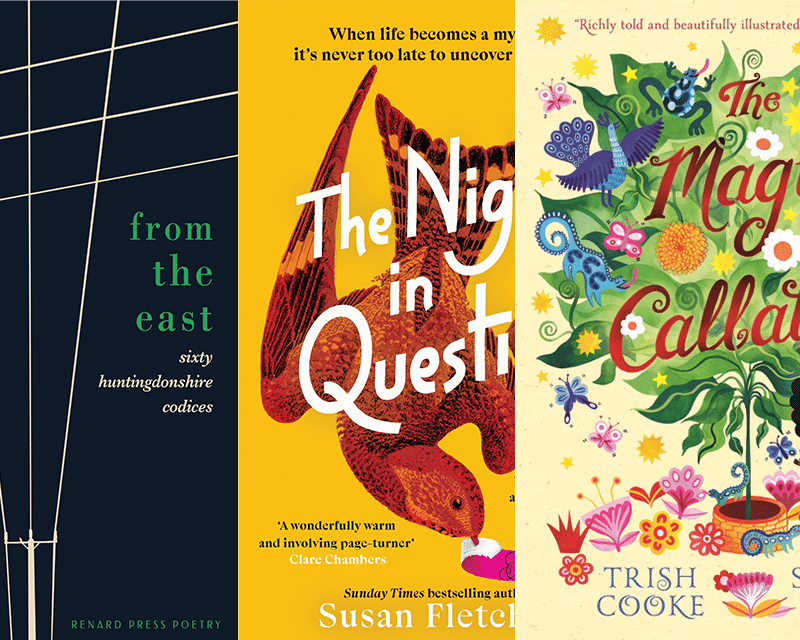- Collected
- Article
‘Only Connect’
Poetry and coincidence

- 12 March, 2018
- John Greening
It is some time in the 1990s, and I’m on the top floor of Kimbolton Castle, the school where I teach, typing up a selection of my poems for an American press. About halfway through, I reach ‘Sestina for the Six Wives’. As I type the lines about Anne Boleyn dancing in a yellow dress on the day of Catherine’s funeral, the computer crashes and I lose the poem. So I restart, reach the same point, and it happens again. On the third attempt I lose everything. Strange enough? Even stranger when you recall that it was in this castle that Catherine of Aragon died.
It’s a good story, and I know it’s true, even if no one else believes me. And whatever the explanation, it is a reminder that poetry does tend to inhabit a curiously twilit world. Unlike T.S. Eliot’s Margate Sands where nothing connects with nothing, in the poet’s head everything connects with everything. You might even say that poetry is a state of hyper-connectedness.
Every poet has a story about synchronicity. One of the most striking was told me by the poet Annie Fisher, who lives near where Edward Thomas heard chiffchaffs when he was ‘in pursuit of Spring’. On the very day a century later, she went to the same spot hoping to hear some, and on returning home was told that a bird very like a chiffchaff had just flown in and perched on her computer. It’s an extraordinary tale, which I can never resist telling, and though I tried to make it into a poem, it’s really much easier to take ordinariness as your starting point (which is why ‘The Rime of the Ancient Mariner’ is such an achievement).
Other stories are quite well known: for example, how the surrealist poet David Gascoyne attended therapy sessions for depression, where they would occasionally read poems. The group leader, Judy, later told the Independent that on this occasion she had chosen ‘a more recent poem that had always intrigued me called “September Sun”’ and announced to the group:
‘This afternoon we’re going to read a poem by David Gascoyne. It’s quite complex so I’ll read it slowly and then we’ll see if we can understand what it means.’ The tall, sad-looking man touched me on the arm and said quietly, ‘I wrote that poem. I’m David Gascoyne.’ I said, ‘I’m sure you are, dear.’ I didn’t believe him for a moment. Some of them do have delusions of grandeur, you see.
He insisted, and when she asked him during the tea-break if he really was the author, he said ‘Of course I am’ and signed the poem. Reader, she married him.
There’s really nothing much one can say to such a tale, except perhaps something about love finding a way. It’s a diverting ‘Convergence of the Twain’ (and how the author of that poem loved coincidence!) — like news of Wilfred Owen’s death reaching his home on Armistice Day or George Mackay Brown’s funeral falling on the feast of his beloved St Magnus. (‘And if you call that a coincidence,’ the minister said, ‘I wish you a very dull life’.)
I have more personal examples than I can possibly relate. The owl in the pub the day I saw my first TLS poem published (about an owl); the mosquito in my ear as I typed a poem about the death of Lord Carnarvon (from a mosquito bite); reading Kipling’s ‘Boots’ just before the song came on the radio; dreaming of R.S. Thomas’s death and waking to hear it announced; showing my poem about the White Horse of Uffington to Penelope Shuttle who showed me in turn she was wearing a necklace with a design featuring the same horse; writing a poem about the railway line at Helpston, then turning on Channel 4 News to see Michael Crick standing… well, you can guess. Indeed, at a dinner last year, a latecomer took the only empty seat, which happened to be next to me. We had little to say, but I vaguely recognised the name: not only a celebrated playwright, it turned out, but someone I had long regretted being unable to meet twenty years ago, someone who knew my wife’s family well, and was closely involved in their tragic history.
Most people, I suggest, do ‘notice such things’ (as Hardy put it) but laugh them off, or shrug them away. For poets they can be a kind of reassurance that the magic is working. In Ted Hughes’s case, he would try and tap into that magic, whether it was the famous dream of a fox-headed creature telling him to switch from studying English at Cambridge (‘Stop this — you are destroying us.’) or the occasion he discovered a small model fox while burying a dead one (his ‘first thought-fox’ Jonathan Bate calls it). But it’s worth remembering too that he consulted astrological charts to find the most propitious dates for his books to appear.
Nowadays, authors are more likely to check who’s on the judging panel of any likely award. What they probably should check is that the gods of synchronicity haven’t led them to write the same book as someone else. Coincidence is often raised as a defence for plagiarism, but sometimes it just feels like the right moment for, say, a novel about Henry James. Three came out at the same time just over a decade ago, though it was Colm Tóibín’s that received all the attention.
The sceptic will suggest that people like me have become so bewitched by coincidence that we see it everywhere. I would agree, and it’s what makes writing poetry so exhilarating. You have to appreciate (as I believe Les Murray said) the doubleness. One of my collections was the result of a pilgrimage to Iceland to track down my father’s wartime ‘Valhall Camp’ — whose very name is inviting to the mythically minded. Iceland Spar takes its title from a kind of calcite which splits light so that everything seen through it appears double. One of the book’s longest poems is a version of ‘Völuspá’, which I called ‘Coming Soon’ and reshaped into a disaster-movie vision of apocalypse. I was printing off the final draft as news came of 9/11. Iceland does seem to have haunted me since. At my mother’s funeral, as we waited for the cortege in our solemn black, a taxi sped up, dazzlingly white, emblazoned ‘ICELAND’. A door opened in the word, and out stepped my best friend — looking for all the world like C.G. Jung. And I felt the grip of coincidence again just this autumn at Hawthornden Writers’ Retreat, where one of the other five Fellows was Icelandic poet Gerður Kristný. Óðinn famously had two ravens, Thought and Memory, one on each shoulder. I think there is a third that maybe he doesn’t tell us about.
My literary coincidences are usually too convoluted to explain or too trivial to mention, mere puns along the way (like that girl reading The Tin Drum as the train stopped at Tyndrum). Or they relate to some private preoccupation, as when I heard I’d had work accepted for the distinguished American journal, the Hudson Review, and strode happily into town, finding myself at a library sale. There on top of the pile were three copies of the Hudson Review for 30p each. Not only is it a very unusual journal to see anywhere this side of the Atlantic (especially in Frome), but I had never actually held a copy in my hands. So, significant to me but no one else really.
If you don’t let it disconcert you, coincidence can be reassuring, even thrilling. You are part of a novel someone else is writing. When Little Gidding proved to be the location for my one and only conversation with Seamus Heaney, it felt like a plot move. And it certainly felt that way last summer during our family holiday in Crete. I was composing a crown of sonnets (to be titled ‘Europa’ until Sean O’Brien got there first), one of the most intricately connected poetic forms, since the last line of each of its fourteen sonnets is the first line of the next, and the whole ‘corona’ ends with a fifteenth made up of those lines. I had wanted to visit the tree where Zeus is said to have brought Europa, but I decided it was too far north.
On our last day, we headed instead to the beach at Matala, not knowing it was associated with Joni Mitchell’s ‘Carey’, my wife’s favourite, a song we used to listen to together. That was coincidence enough, but on the way there our taxi driver suddenly pulled over at an archaeological site, Gortyna, and said he would take a smoke while we looked around. It wasn’t anywhere we’d planned to come. But inside, beyond the Odeion and the sixth-century engraved Laws of Gortyna, to my astonishment, I found the very thing I had most wanted to see, that I had mistakenly believed to be out of reach: the evergreen plane tree of Europa.
You might also like:
No facts, only versions
Memoirs are as much about what is excluded as what is included. This edition examines how you can evoke the…
RLF Fellows’ News: April 2024
Publishing News RLF Fellow Trish Cooke’s new children’s book, The Magic Callaloo, is set to be published by Walker Books…
Susan Fletcher on outsiders in fiction – literal and imagined
I’ve always known that I’ve preferred to be outside. To be an outsider – literally, and, specifically, amongst wild places…


